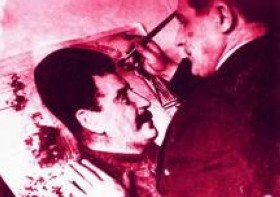


Boris Bertram: Krigskampagnen
Boris Bertrams ”Krigskampagnen” havde premiere på DR2 Dokumania tirsdag, 19. marts 2013 nøjagtigt ti år efter krigen begyndte. I morgen aften skal den ses og drøftes sammen med Janus Metz: ”Armadillo” i FILMKLUB FOF, Randers. ”Krigskampagnen havde på tv fået titlen “Bush, Blair og Fogh”. Og det var måske ikke urimeligt, det var deres krig, og på DR tænker de filmjournalistik, når de skriver ”dokumentar”. Vi skal have at vide lige fra begyndelsen, at det er om dem, de tre og ingen andre. På filminstituttet tænker de filmkunst, når de skriver ”dokumentar”. Deres hjemmesides filmupdate kalder den “en dokumentarisk politisk thriller”. Formodentlig har Bertram også tænkt filmisk og filmkunst undervejs, men heldigvis, faktisk, er den tanke, hvis den har været der, blevet lagt helt til side, så der ikke er filmkunstneriske ambitioner, end ikke filmiske greb i resultatet, selv om der bestemt kunne være fristende muligheder i materialet. Nu fremtræder dokumentaren som et stilrent og helstøbt journalistisk værk for tv. Og det er godt, for det er en fremragende tv-dokumentar.
Boris Bertram har jo snakket med alle disse kloge og velformulerede folk, som er er med i filmen og naturligvis flere til og læst alle artiklerne, alle rapporterne og alle bøgerne, og så gør han alligevel det, at han i sin kommentar i fortællerstemmen nøjes med et nøgternt handlingsreferat. Nu må du selv bedømme, mærker jeg, han siger bag det, og den nødvendige samlede analyse og samlede overvejelse og samlende vurdering lægger han fra sig. Her er det journalistiske materiale lagt velordnet frem i en tv-dokumentar, det er hans opgave i dette projekt, og den er løst. Det litterære essay overlader han til mig som seer at skrive selv, og filmessayet afstår han som nævnt fra.
Klipperen Pernille Bech Christensen deler som i et gammeldags lysbilledforedrag dette stof op, roligt pauseret i en auditoriets skandering (vi ser faktisk Kodak Carousellen som gentagen vignet før hvert afsnit og hører dias glide på plads i et sikkert klik). Og det er fint. Og det er på samme måde velgørende at få vidnernes udsagn et for et i rolig rytme, ikke klippet i enkeltsætningers udsagn som en omsiggribende norm byder, men lagt på plads, her ikke i filmscener, for det skal det netop ikke være, men i lange meningsfulde, også følelsesmæssigt meningsfulde, sammenhænge, så vidnets menneskelighed foldes ud. Og ja, så er det da (politisk thriller eller ej) regulært spændende at få repeteret begivenhederne for tolv år siden. Jeg husker det jo godt, men min erindring var før mødet med filmens kompetente fremstilling bestemt ikke et velordnet overblik eller dramatisk forløb.
Det sidste, et drama, er det mærkeligt, men tydeligt for mig blevet nu, for det viser sig, at inde i det effektive klip med en flot kurve i kombinationen af blokke af information ordnet i emner og en kronologisk fremdrift styret af fortællestemmen ligger et intenst kammerspil af frustrerede stemmer, en smertefuld resignation, afdæmpet i tilbageblikket spændt op mellem undertrykt ærgrelse (især hos den daværende britiske USA ambassadør Christopher Meyer) og dæmpet vrede (i hvert fald hos lederen af FN’s våbeninspektion Hans Blix). Jeg mærker tydeligt, at her ligger den oplagte kunstneriske kerne, det filmiske drama, faktisk klippet frem, men valgt bort og skjult i tv-dokumentarens illustrerende billeddækning i et nøje udsøgt forløb af citater fra nyhedsprogrammerne dengang. I disse blokke af informationer og en kronologi styret af fortællerstemmen, ligger altså et intenst kammerspil af skuffede og vrede, men afklarede stemmer, et umisteligt kammerspil, jeg forstår måtte svigtes. Men det drama har jeg for mig selv, i mig selv som en ikke virkeliggjort bonus.
Til gengæld står der klart og tydeligt for mig en forbilledlig tv-dokumentar, et journalistisk værk, som uden at formulere det selv, faktisk er et uomgængeligt anklageskrift i den store klassiske j’accuse tradition, som der heller ikke her behøver at blive skrevet noget til. Det skrift kan ikke overses, det kan ikke glemmes. Næste lovovertrædelse finder jo allerede sted.
Danmark, 2013, 59 min. Produceret af Magic Hours Film, København for DR: DRsales/Programmes/Documentary
Dokumentaren kan ses på bibliotekernes streaming, Filmstriben: http://www.filmstriben.dk/fjernleje/film/details.aspx?filmid=9000000901
og altså i aften i FILMKLUB FOF, Randers: http://www.fof.dk/randers/Kursusoversigt/Filmklub%20FOF
THE WAR CAMPAIGN, SYNOPSIS
The War Campaign is a genuine political thriller that investigates the campaign carried out by USA, UK, and Denmark in order to sell the war on Iraq to the international community.
When George W. Bush took office in January 2001, regime change in Baghdad was already a top priority, and the sentiment following the 9/11 attacks provided an opportunity to gain support for a pre-emptive war on Iraq, despite the fact that Saddam Hussein had nothing to do with 9/11.
2013 marks the 10th anniversary of the invasion of Iraq by a coalition of willing nations. The concept of a pre-emptive war was itself new, and the lead-up to the decision constituted a shift in democratic decision processes. It is time to examine the anatomy of the decision-making process itself in order to understand the art of campaigning for parliamentary and public acceptance of a decision already made.
The War Campaign features the individuals, who were given the complicated task of accruing political support for the invasion from the international community. Centrally-placed witnesses, policy-makers, their close advisors and speech-writers, take us into the very offices where plans were drawn up and followed through, intelligence gathered and tailored, ‘white papers’ or speeches written and revised. Some of these individuals at some point felt that the governments they worked for, crossed a questionable line, and they decided to inform the public of the process. It is their detailed accounts of what exactly took place that now allows us to understand.
By piecing together each step of the war campaign we gain insight into the mechanisms behind international coalitions and the semantics of selling policies. We question whether the ‘selling of’ policies carries the risk of undermining normal democratic processes, – especially if policies are not based on the information at hand, but the information is tailored to fit political goals instead. (DR katalog)


